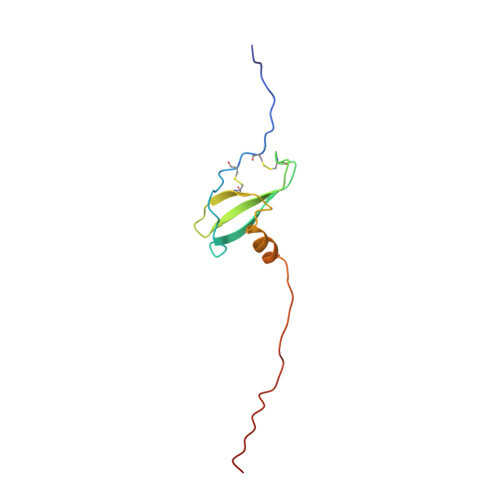Solution structure of CXCL13 and heparan sulfate binding show that GAG binding site and cellular signalling rely on distinct domains.
Monneau, Y.R., Luo, L., Sankaranarayanan, N.V., Nagarajan, B., Vives, R.R., Baleux, F., Desai, U.R., Arenzana-Seidedos, F., Lortat-Jacob, H.(2017) Open Biol 7
- PubMed: 29070611
- DOI: https://doi.org/10.1098/rsob.170133
- Primary Citation of Related Structures:
5L7M - PubMed Abstract:
Chemokines promote directional cell migration through binding to G-protein-coupled receptors, and as such are involved in a large array of developmental, homeostatic and pathological processes. They also interact with heparan sulfate (HS), the functional consequences of which depend on the respective location of the receptor- and the HS-binding sites, a detail that remains elusive for most chemokines. Here, to set up a biochemical framework to investigate how HS can regulate CXCL13 activity, we solved the solution structure of CXCL13. We showed that it comprises an unusually long and disordered C-terminal domain, appended to a classical chemokine-like structure. Using three independent experimental approaches, we found that it displays a unique association mode to HS, involving two clusters located in the α-helix and the C-terminal domain. Computational approaches were used to analyse the HS sequences preferentially recognized by the protein and gain atomic-level understanding of the CXCL13 dimerization induced upon HS binding. Starting with four sets of 254 HS tetrasaccharides, we identified 25 sequences that bind to CXCL13 monomer, among which a single one bound to CXCL13 dimer with high consistency. Importantly, we found that CXCL13 can be functionally presented to its receptor in a HS-bound form, suggesting that it can promote adhesion-dependent cell migration. Consistently, we designed CXCL13 mutations that preclude interaction with HS without affecting CXCR5-dependent cell signalling, opening the possibility to unambiguously demonstrate the role of HS in the biological function of this chemokine.
Organizational Affiliation:
University of Grenoble Alpes, CNRS, CEA, IBS, 38000 Grenoble, France.














